137 CD / The Welte Mignon Mystery Vol. III: Richard Strauss
Description
This is not an historical recording. Yet mysteriously the music is performed in an interpretation which is historically authentic down to the last detail. The key to this mystery is: the original performer was present at the recent recording session, but not physically: the music is heard on a modern Steinway. Never has music stored in the Welte-Mignon system sounded so "right" or so well. Thanks to TACET′s much-praised recording technique, and because the Welte-Mignon memory system and sound production mechanism have now been newly adjusted for the first time by the leading expert in the field - and are thus able to meet TACET′s requirements. (Welte-Mignon was invented in 1904.) The Welte-Mignon mystery can now speak to us without distortion.
4 reviews for 137 CD / The Welte Mignon Mystery Vol. III: Richard Strauss
You must be logged in to post a review.

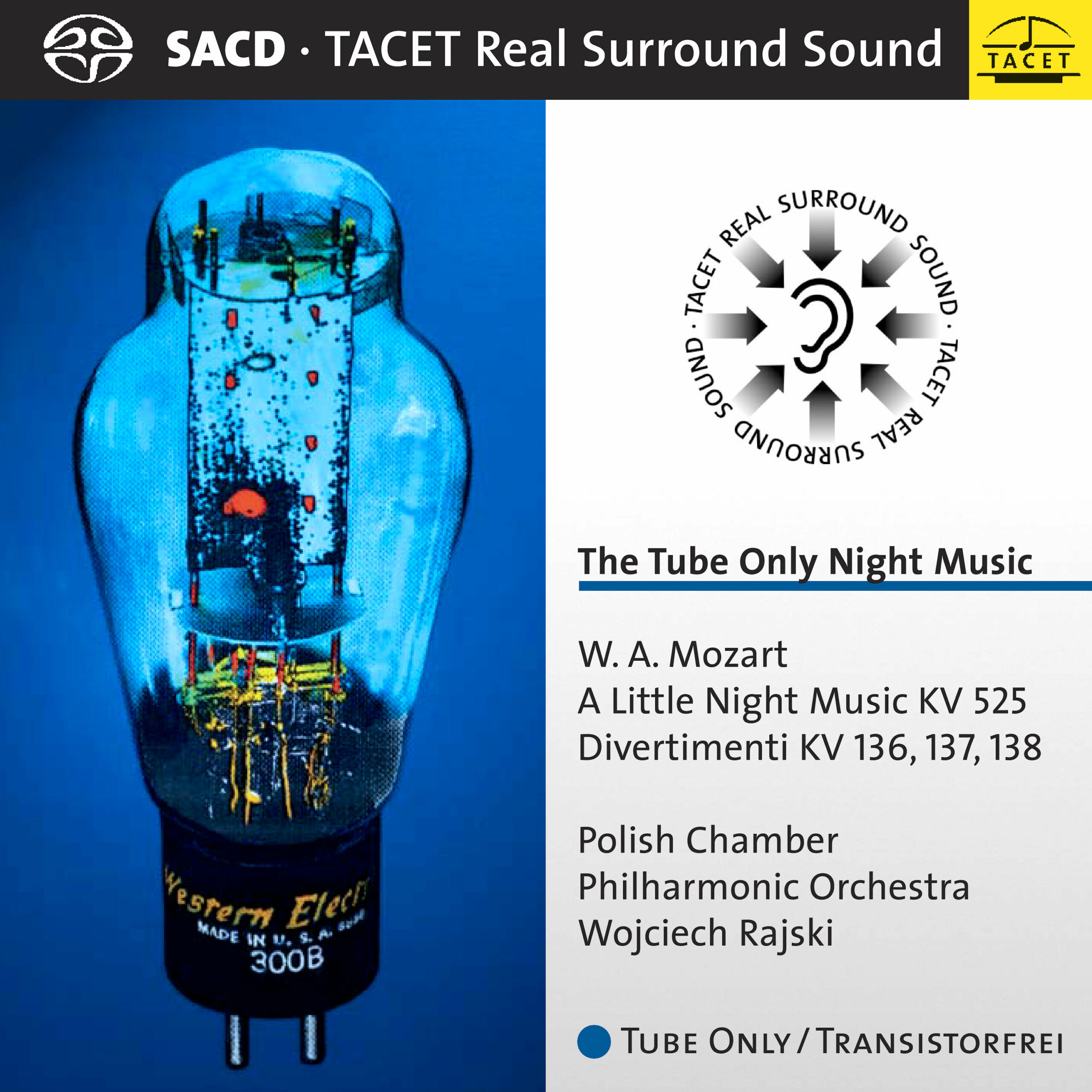
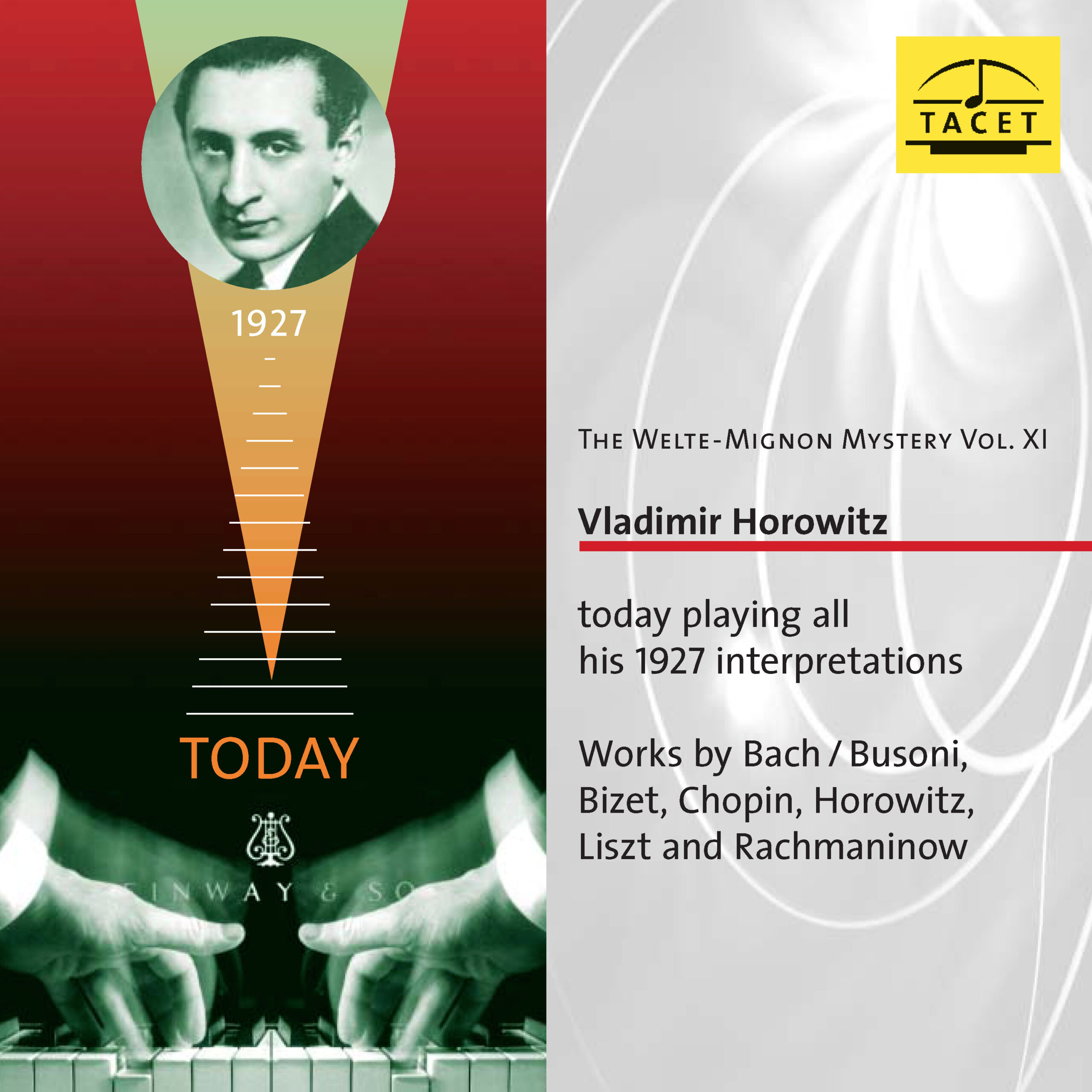
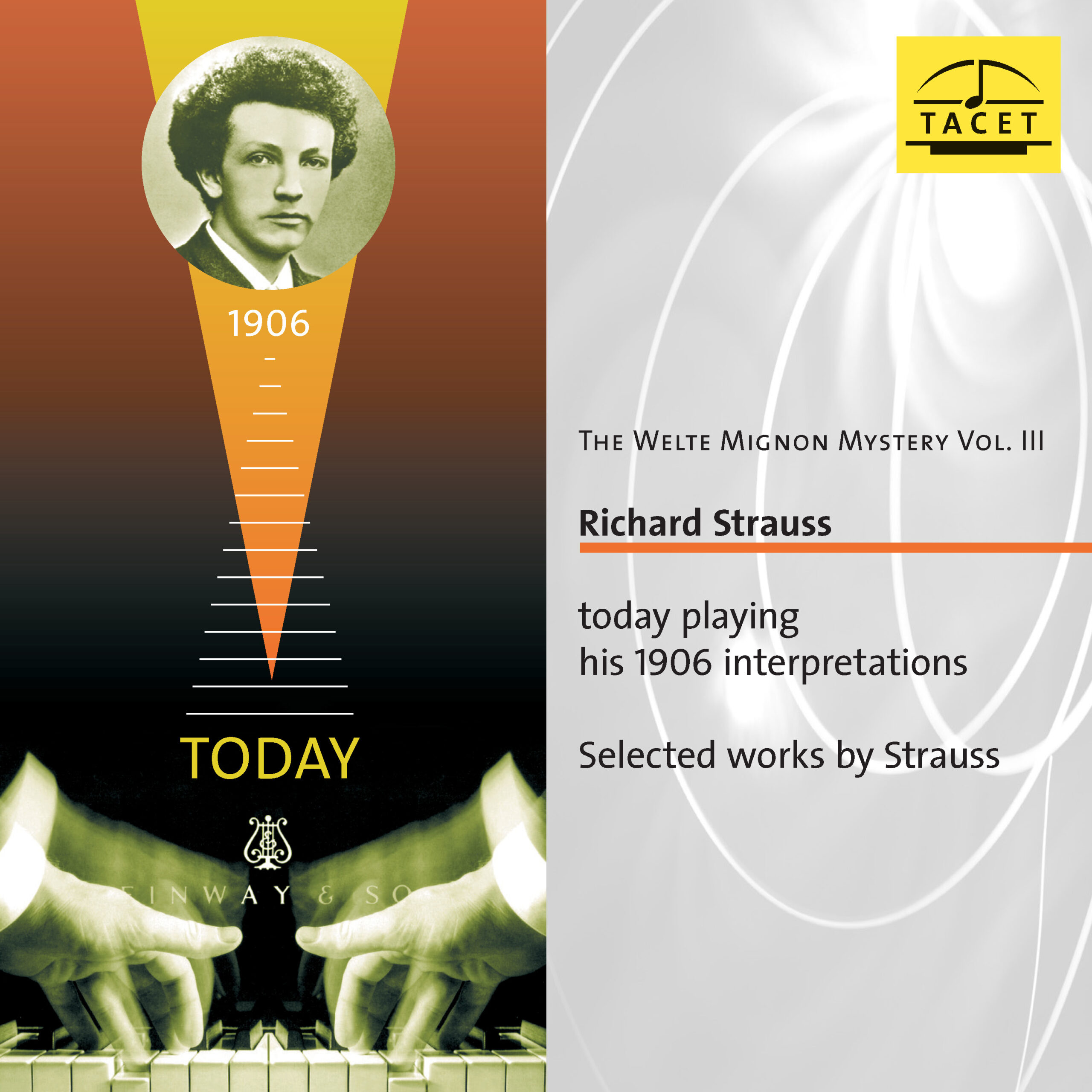
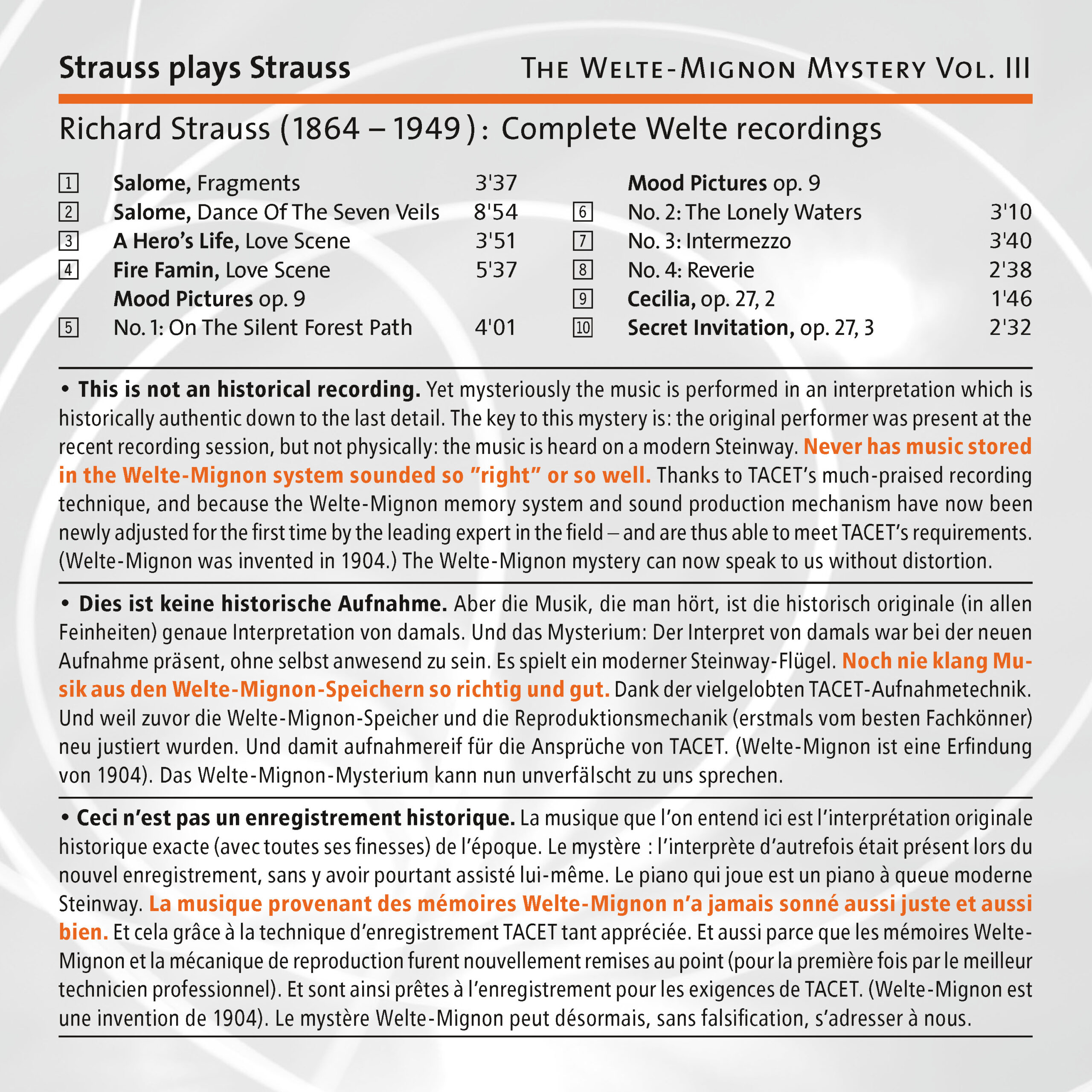

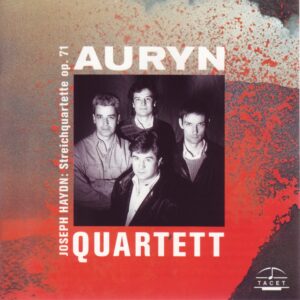
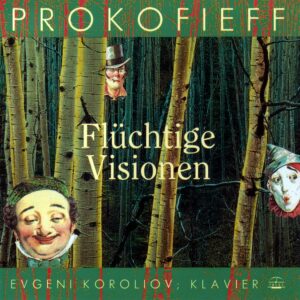
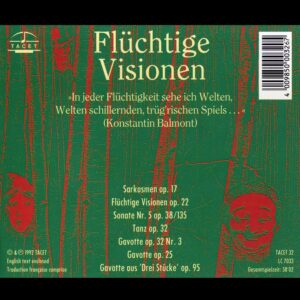
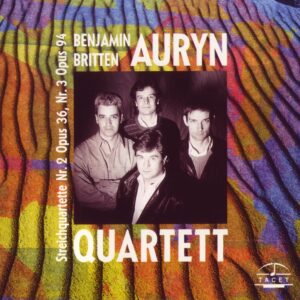
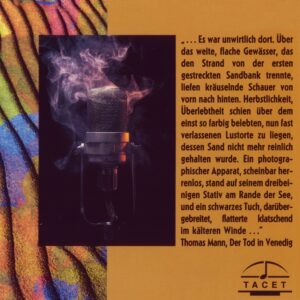
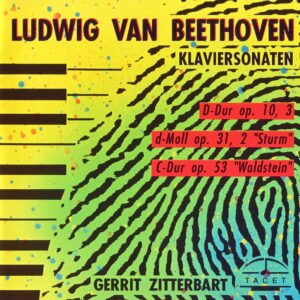
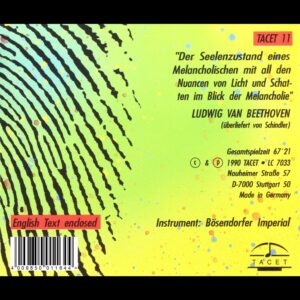
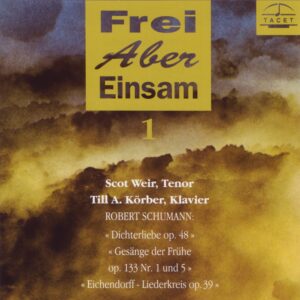
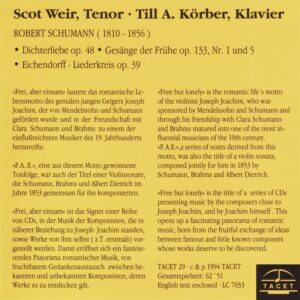

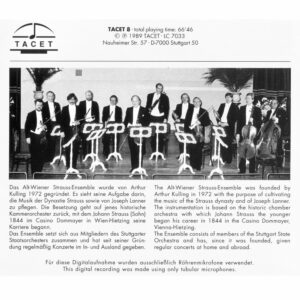
Pianiste –
THE LESSONS OF THE PAST
The Magic of the Welte-Mignon
Debussy, Ravel, Mahler, Einecke, Grieg, Granados… spielen ihre Werke.
Would you like to hear Ravel, Debussy, Strauss, Saint-Saëns, and Reger playing their own works on a modern piano? And how about a "perfect" restoration of the interpretations by the early Horowitz, Fischer, Lhévinne, and Schnabel? The German label Tacet offers an anthology of rolls recorded by the Welte-Mignon system. The system is simple, but the process of reproduction is particularly complex! In fact, the pieces played by the composers themselves were digitized from the device invented in 1904 by the company Welte & Sons of Freiburg. The perforated rolls of the time captured the touch, pedal play, and the finest nuances. Today, all that is needed is to transfer these recordings onto a concert piano.
It is therefore a real shock to hear, in optimal listening comfort, Debussy’s Children's Corner and some Préludes, as well as Ravel’s Sonatine and Valses nobles et sentimentales, all played by the composers themselves. What lessons can we take away from this? First, the astonishing freedom with which these two geniuses approach their scores! It is also true that Ravel’s playing is not always flawless… But if we look beyond the purely technical aspect, we notice the extreme finesse and personalization of their touches. The dynamics are generally soft, with the fingers seeming to merely caress the keyboard. No brutality whatsoever. The clarity and gentleness are astounding. Other examples are equally striking, such as the two volumes dedicated to Brahms’ works interpreted by Nikisch, Lhévinne, Samaroff, Ney, or Chopin’s Etudes played by Pachmann and Paderewski…
The virtuosity of these pianists is staggering, but even more surprising is the passion, the commitment, and sometimes even the coquettishness, the occasional unnecessary ornamentations that some perform almost as if they were tics. From all these master lessons, we learn that the strongest personalities only flourish after a visceral and profound understanding of the works. Schnabel in the waltzes of Josef Strauss and Josef Lanner (who would dare play this today?), Horowitz in 1926 in some Rachmaninoff Preludes, speak to us. Where does the charisma and charm of their interpretations come from? A mystery.
Every year, Tacet releases three or four new CDs from the Welte-Mignon archives. Worth collecting.
S. F.
_________________________________________________
Original Review in French language
LES LEÇONS DU PASSÉ
La magie des Welte-Mignon
Debussy, Ravel, Mahler, Einecke, Grieg, Granados… jouent leurs œuvres.
Vous aimeriez entendre Ravel, Debussy, Strauss, Saint-Saëns, Reger jouant sur un piano d’aujourd’hui leurs propres Oeuvres? Et que diriez-vous aussi d’une restitution « parfaite » des interprétations des premiers Horowitz, Fischer, Lhévinne et autres Schnabel? Le label allemand Tacet propose une anthologie des rouleaux gravés par le procédé Welte-Mignon. Le système est simple, mais le procédé de restitution particulièrement complexe! En effet, les pièces jouées par les compositeurs eux-mêmes ont été numérisées à partir de l’appareil inventé en 1904 par la firme Welte & Fils de Fribourg. Les rouleaux perforés de l’époque ont capté le toucher, le jeu des pédales et les nuances les plus fines. Il suffit aujour¬d’hui de transférer ces témoignages sur un piano de concert.
C’est donc un véritable choc que d’entendre dans un confort d’écoute optimal les Children’s Corner et quelques Préludes par Debussy, mais aussi la Sonatine, les Valses nobles et sentimentales de Ravel sous les doigts des compositeurs. Quelles leçons en retirons-nous? D’abord, l’étonnante liberté de ces deux génies vis-à-vis de leurs partitions! Il est vrai aussi que le jeu de Ravel n’est pas d’une justesse infaillible… Mais si l’on dépasse l’aspect purement technique, on s’aperçoit de l’extrême finesse et de la personnalisation des touchers. Les dynamiques sont généralement faibles, les doigts semblent effleurer le clavier. Sans aucune brutalité. La clarté et la douceur sont stupéfiantes. D’autres exemples sont frappants comme ces deux volumes consacrés à des œuvres de Brahms interprétées par Nikisch, Lhévinne, Samaroff, Ney ou bien les Études de Chopin par Pachmann et Paderewski…
La virtuosité des pianistes est stupéfiante, mais on est plus surpris encore par la fougue, l’engagement, parfois même les coquetteries, les ornementations intempestives que certains provoquent comme des tics. De toutes ces leçons de maîtres, on retient que les personnalités les plus fortes ne s’épanouissent qu’après une compréhension viscérale et profonde des œuvres. Schnabel dans les Valses de Josef Strauss et de Josef Lanner (qui oserait jouer cela aujourd’hui ?), Horowitz en 1926 dans quelques Préludes de Rachmaninov nous interpellent. D’où proviennent le charisme et le charme insensés de leurs lectures? Mystère.
Chaque année, Tacet publie trois ou quatre nouveaux CD des archives Welte-Mignon. À thésauriser.
S. F.
Audiophile Audition –
Rube Goldberg-style gear achieved in 1906 the utmost realism possible in piano roll cutting, now heard in stereo with a phantom composer at the keyboard
The liner notes to this restoration open with the disclaimer:
"This is not an historical recording: quite the opposite. TACET′s recording techniques, renowned for their crystal clarity and spaciousness, score another triumph here."
Invented in 1904, Welte-Mignon piano rolls quite accurately recorded an artist′s touch and tempo indications on the paper rolls‚ possessing 80-88 control tracks and further tracks at the edges for controlling the dynamic nuances and for operating the pedals. Adjusted for height, the Vorsatzer device was pushed up against the piano keyboard so that the felted fingers lay exactly on the keys.
Thus, the session by Richard Strauss in 1906 at the Welte-Mignon studio is herein duplicated on a modern Steinway D, and we can hear his own realizations of some of his own repertory. Strauss always claimed his music should possess the same lightness we find in Mendelssohn. Those who hear in Strauss only purple prose may find some unexpected lucidity and charm in the composer′s renditions (16 February 1906) of the Salome passages, with his undemonstrative yet supple rhythm quite effectively delineating transitions and contextual thickness. The major entry is Salome′s Dance of the 7 Veils, in rippling piano Technicolor.
The Mood-Pieces are particularly telling: small character-pieces quite like Mendelssohn and Schumann, they ring true under Strauss′ hand in The Lonely Waters and Reverie. The two love-scenes, from Ein Heldenleben and Feuersnot respectively, seem to confirm Beecham′s chosen tempos in the his orchestral renditions. The two Op. 27 songs enjoy a diaphanous transcription to the keyboard, the lushness of the sentiment of Cecilia coming through without aggressive percussion on the part of Strauss.
At just forty-and-one-half minutes, few record-buyers are going to jump at this recording: but those who do can play all sorts of sophisticated party jokes, keeping their guests wondering who made such a facile piano reduction of Salome′s erotic dance.
Gary Lemco
Pizzicato –
Strauss was forty years old when he recorded this selection of his own works using the Welte-Mignon process in 1906. The rolls now allow us to experience Strauss "live" at the piano in the original sound. This also makes it possible to fully appreciate the famous Strauss interpretation style in optimal quality. The music always sounds unobtrusive, almost casual—no demonstrative effects, but absolute naturalness and organic flow. If one transfers this in one's imagination to an orchestral setting, it becomes clear how far most conductors stray from the original. A somewhat short, but very instructive and highly fascinating release.
Steff
Klassik heute –
The idea is compelling, the execution exemplary, and the result more than satisfying! Richard Strauss’s 1906 Welte-Mignon recordings are here "reproduced" on a modern Steinway—that is, the player-piano system was connected to a contemporary instrument. It remains fascinating to experience Strauss as a moody, sometimes cantankerous interpreter of his original piano works, as a transcriber of his own songs, and as a quasi-répétiteur of both famous and lesser-known operatic passages. This is not great pianism in the traditional sense, but rather the chance to hear, so to speak, the voice of the master himself—unadorned, delivered on the cool flame of the keyboard. If you like, you might call it an acoustic wax museum, or more kindly, a posthumous encounter via CD. Detailed technical notes enhance the value of this 40-minute edition, which surpasses all previous LP and CD releases in every respect.
Peter Cossé